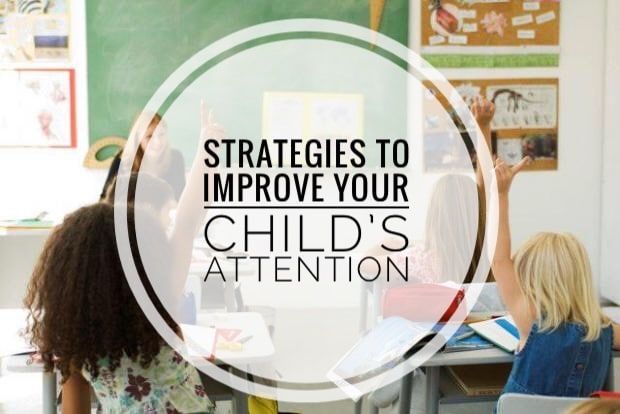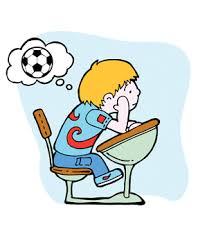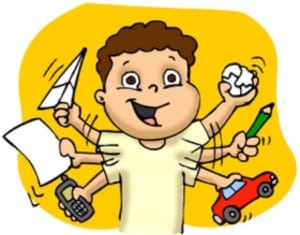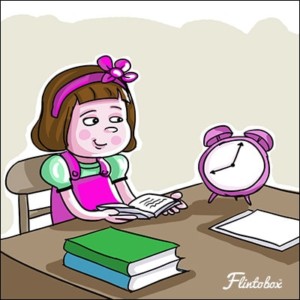This Scribble was scribbled by Megan Abdelnour, Occupational Therapist, M.Sc.
The ability to focus attention on different tasks and activities forms the basis of all learning—it is the most important foundation skill. Some children may become distracted more easily or have difficulty focusing on instructions. If they are not able to pay attention and listen they will be unable to properly process the information they are given.
The skill of attention usually starts with attending to people, then to objects, then being able to share attention between various people and/or objects. It is normal for young children only to be able to focus on a task for short periods of time; however, their attention span should increase as they age.
Some children have more difficulty than their peers with maintaining attention on tasks–not just occasionally, but frequently and across many different settings/environments, school subjects, and activities/topics. For these children, the first step is recognising some of the signs that attention may be a more challenging area for your child.
What are some of the signs that your child may have difficulties with attention?
Consider your child and age-appropriate attention span first! However, if you suspect your child has difficulties with attention that are outside of what is typical development, you may observe you’re your child frequently demonstrates several or all of the following:
- May appear to frequently ignore you
- Has significant difficulty with sitting still
- May talk or move when they should be listening
- Has difficulty telling you what you have been talking about or answering questions about a story that has just been read or discussed
- Can have difficulty following instructions
- Can only concentrate on one thing
- Can be easily distracted
- Moves from task to task frequently instead of settling on one activity
If you think your child may have difficulties with attention, there are several strategies and adaptations you can implement to help improve their attention span during everyday activities. We recommend working with your child’s therapist to find what works best for you!
What are some strategies I can implement to help improve my child’s attention?
Positive Reinforcement
- Give your child a feeling of success. Start with a preferred activity your child really enjoys and one he or she can achieve without too much difficulty. Praise your child. This can be done with your enthusiastic voice, a pat in the back, a hug, etc.
- Motivation is important! Try to adapt games so they are motivating and interesting to your child. For example, if you are working on colouring skills, let them colour in their favourite animal, car, etc.
- Consistent praise and firmness to ensure completion of each task will help their attention.
- You may introduce “start/finish” boxes. Give a reward if all the activities are achieved.
- Follow your child’s lead during play. Join in what they are doing.
Environmental Adaptations
Some children are easily distracted by any noises or the sight of objects in a room. You can help your child with increasing his or her attention span by setting up a favourable setting to work and different strategies.
- Choose a time where your child is most alert during the day and when you can give one-on-one attention. Make these sessions part of your daily routine.
- Choose a quiet place in your home to work on homework or activities. If possible, set up a child size table and chair.
- Cut down noise (no TV, no radio ). Facing a blank wall is ideal. If you are near a window, close the curtains to minimize distractions.
- Keep the table clear of all articles that are not being used. Your child can be taught to clear his or her work area before moving onto the next activity.
Presenting Tasks in a Different Way
- Present one activity at a time and limit the conversation to the task at hand.
- Break activities/tasks into short, basic steps and teach only one skill at a time.
- Use timers, such as sand, egg, or visual timers (e.g. Time Timer) to visually show the child how long you want them to listen or join in for. Challenging them to increase the amount of time they attend to one task at a time, e.g. start with 2 minutes and when they accomplish that, add 30 seconds, etc.
- Alternate between quiet tasks and more active tasks. Intermittent movement breaks, e.g. jumping jacks, yoga, animal walks, and/or outdoor play activities, can help to improve a child’s overall attention. This is important both at home and at school.
Use Simple, Direct Instructions and Predictable Routines
- Speak simply when you demonstrate an activity. Use as few words as possible and be direct.
- Combine verbal commands (“Look!”) with visual cues (point to an object, pick up an object) or with tactile cues (gently touch them on the foot, shoulder, etc.) to gain their attention.
- Ensure that each task is completed before moving onto the next one—children should learn that activities have a beginning, middle, and end.
- Predictable routines are helpful for improving attention—create a written or visual schedule for your day or for a specific time period (e.g. if you are playing for 30 minutes, write a list of which games you will play and have your child tick them off as they are completed).
Play Fun Games to Improve Attention
Listening games:
- Simon Says
- Story books: Listen to a short story and see if your child can respond to simple questions about what happened. Can they predict what will happen next? Can they identify the characters? Can they retell the story in their own words?
- Musical games: Use shakers, drums etc. to make two, three, or more sounds in a sequence. The child needs to then copy the sequence.
- Freeze dance
Turn Taking:
- Sit in a circle and take turns to play motivational games such as passing a clap or hand squeeze around a circle, fishing, ‘telephone’.
- For older children, say their name, favourite food, or matching a word to a letter (e.g. “A is for apple”, “B is for balloon”, etc.) when a ball or beanbag is thrown to them.
“Ready, steady, go” games:
- Rolling a ball back and forth using “ready, steady, go” countdown.
- ‘Red light, Green light’
- Incorporate “waiting”. For instance, encourage the child to sit and wait for ‘go’ before they do an activity e.g. knocking down blocks, rolling a car, the child pinching the end of an inflated balloon and waiting for ‘go’ before letting go, etc.
Memory games:
- Memory pair card/image games
- Memory matching games: matching upper/lowercase letters, shapes, animals, rhyming words, etc.
- Shopping list game or “I went shopping and I bought…”
- ‘What’s missing?’ game
Note: If you suspect your child may have difficulties with attention, please also consult your child’s doctor and/or therapist.






Leave A Comment